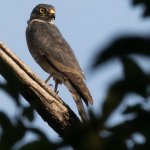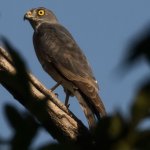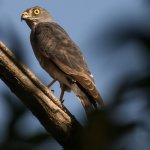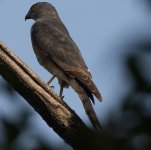Aladdin
Well-known member

Dear members and bird watchers!
I did some bird watching in Suan Rot Fai, Bangkok this afternoon. I walked, I don't want to call it a forest, but it was a stretch with a dense foliage. So it felt like walking in the forest for 50 meters or so. Anyway, there was a small hole in the canopy. I don’t know how I manage to spot the bird in the very small opening.
I took pictures and I had no clue what bird it was. Coming home and I spent quite some time in my books and on internet to get the ID. First I thought it was a Falcon, but the bird did not have hairy legs so I gave up that idea. 30 minutes later, and I had been working with the Chinese Sparrowhawk. Looked quite like, except for the yellow eyes. But after a lot of looking around I found out that the female have yellow eyes.
Is here anyone on the forum that can be so kind to tell me if I am right or wrong, female Chinese Sparrowhawk?
Kind regards and happy birding
Aladdin
I did some bird watching in Suan Rot Fai, Bangkok this afternoon. I walked, I don't want to call it a forest, but it was a stretch with a dense foliage. So it felt like walking in the forest for 50 meters or so. Anyway, there was a small hole in the canopy. I don’t know how I manage to spot the bird in the very small opening.
I took pictures and I had no clue what bird it was. Coming home and I spent quite some time in my books and on internet to get the ID. First I thought it was a Falcon, but the bird did not have hairy legs so I gave up that idea. 30 minutes later, and I had been working with the Chinese Sparrowhawk. Looked quite like, except for the yellow eyes. But after a lot of looking around I found out that the female have yellow eyes.
Is here anyone on the forum that can be so kind to tell me if I am right or wrong, female Chinese Sparrowhawk?
Kind regards and happy birding
Aladdin







